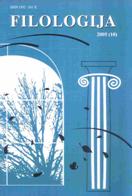Rudens lapų spalvų raiška lietuvių poezijoje
The Expression of Tree Leaves’ Colours in Autumn in Lithuanian Poetry
Author(s): Rūta Kazlauskaitė Subject(s): Language and Literature Studies
Published by: VšĮ Šiaulių universiteto leidykla
Keywords: methaphor; metonymy; metaphtonymy; stereotype; linguistic picture of the world
Summary/Abstract: The article is intended to define what colours are used to describe tree leaves in autumn in Lithuanian poetry and what means of speech indicate these colours. 425 examples found in poems, written by 86 lithuanian poets, are referred to as illustrations. 1. The object of investigation is defined by words lapas ‘leaf’, lapai ‘leaves’, lapija ‘leafage’, metonymies, that are formed when the meaning is based on space or time transfer: medis ‘tree’ (klevas ‘maple’, beržas ‘birch’...), krūmas ‘bush’; vainikas ‘wreath’, (medžio) šaka ‘a branch (of a tree)’, (medžio) viršūnė ‘a top (of a tree)’; sodas ‘garden’, giria ‘woods’, miškas ‘forest’ (beržynas ‘birch forest’...), parkas ‘park’; alėja ‘alley’; peizažas ‘scenery’, gamta ‘nature’, tėvynė ‘homeland’, žemė ‘ground’; metų laikas ‘season’, mėnuo ‘month’; ruduo ‘autumn’, rugsėjis ‘September’, spalis ‘October’, lapkritis (ys) ‘November’, and metaphors. 2. In almost half of the examples the colour of leaves is defined directly by verb forms, adjectives, and adverbs. Ussually the words with the roots gelt (it means yellow colour) and raud/raus/rud/rūd (it means red and brown colours) are used. Unmarked root – the first one – makes half as much again of the examples as the another root. Other words denoting colours – balkšvas ‘whitish’, pilkas ‘grey’, juodas ‘black’, žydras ‘skyblue’, mėlynas ‘blue’; oranžinis ‘orange’, purpuras, inis ‘purple’, chaki ‘khaki’, rubininis ‘ruby’, šokolado ‘chocolate’ – occurred once or twice. The names of intense and concentrated colours are dominating. 3. Due to expressiveness the bright colour of tree leaves is specified using similes and tropes. The words expressing leaves and trees metaphorically are related to liquids (e. g. kraujas ‘blood’, ašara ‘tear’, verkti ‘to weep’), the sources of light (e. g. saulė ‘sun’, ugnis ‘fire’, liepsnoti ‘to flame’), living beings (especially people), and parts of their body (e. g. drugys ‘moth’, vienuolis ‘monk’, rengtis ‘to clothe’; galva ‘head’, ), materials (especially metals), and items made of them (e. g. auksas ‘gold’, gintaras ‘amber’; moneta ‘coin’, kepurė ‘cap’). Autumn always conduct oneself as working man, God. In that way the metaphorical epithets, e. g. kruvinas ‘bloody’, saulėtas ‘sunny’, auksinis ‘gold’, rudaplaukis ‘redhaired’, are found in poetry.
Journal: Filologija
- Issue Year: 2005
- Issue No: 10
- Page Range: 42-51
- Page Count: 10
- Language: Lithuanian

